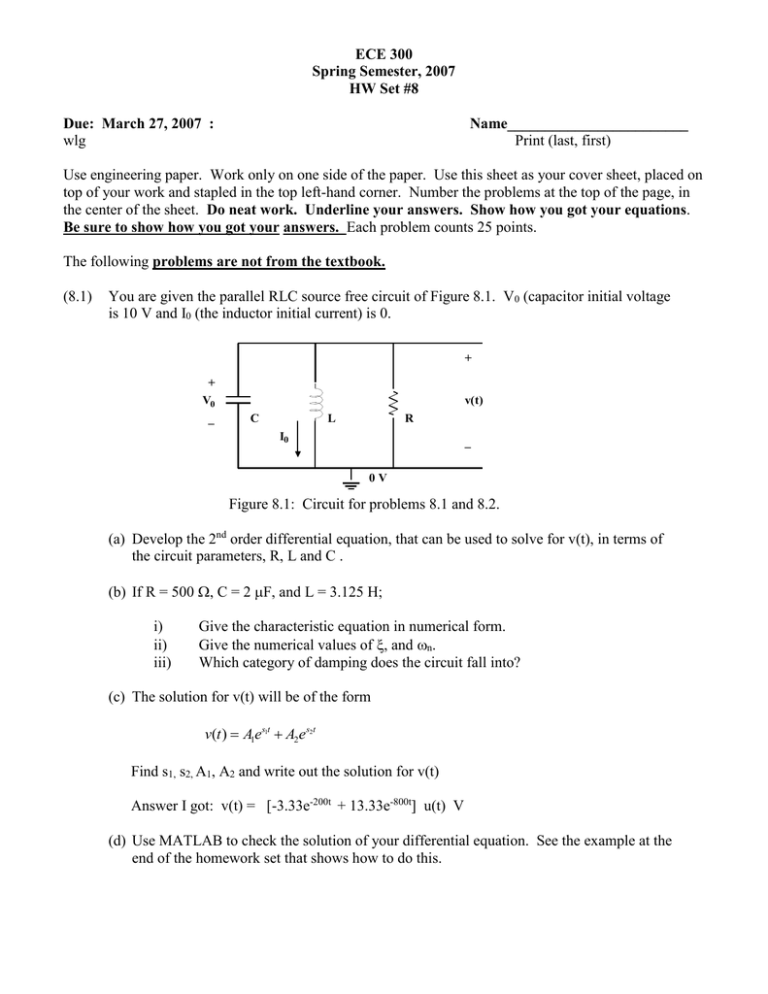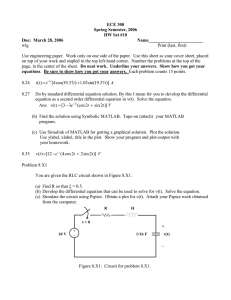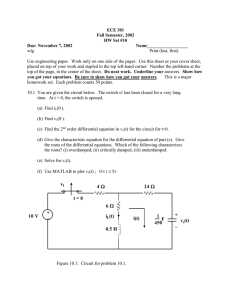ECE 300 Spring Semester, 2007 HW Set #8
advertisement

ECE 300
Spring Semester, 2007
HW Set #8
Due: March 27, 2007 :
wlg
Name________________________
Print (last, first)
Use engineering paper. Work only on one side of the paper. Use this sheet as your cover sheet, placed on
top of your work and stapled in the top left-hand corner. Number the problems at the top of the page, in
the center of the sheet. Do neat work. Underline your answers. Show how you got your equations.
Be sure to show how you got your answers. Each problem counts 25 points.
The following problems are not from the textbook.
(8.1)
You are given the parallel RLC source free circuit of Figure 8.1. V0 (capacitor initial voltage
is 10 V and I0 (the inductor initial current) is 0.
+
+
V0
_
v(t)
C
L
R
I0
_
0V
Figure 8.1: Circuit for problems 8.1 and 8.2.
(a) Develop the 2nd order differential equation, that can be used to solve for v(t), in terms of
the circuit parameters, R, L and C .
(b) If R = 500 , C = 2 F, and L = 3.125 H;
i)
ii)
iii)
Give the characteristic equation in numerical form.
Give the numerical values of , and n.
Which category of damping does the circuit fall into?
(c) The solution for v(t) will be of the form
v(t ) A1e s1t A2e s2t
Find s1, s2, A1, A2 and write out the solution for v(t)
Answer I got: v(t) = [-3.33e-200t + 13.33e-800t] u(t) V
(d) Use MATLAB to check the solution of your differential equation. See the example at the
end of the homework set that shows how to do this.
(e) Hand sketch the response you expect for v(t). This does not need to be accurate. However to
give you a little insight, find the max/min by taking the derivative of v(t) and solving for zero
slope. You should be able to give a reasonable estimate of how long it takes for v(t) to
approach steady state.
(f) Write a MATLAB program that can be used to plot v(t). Compare the output with your
estimate with your computer output. Include your program and plot with your homework.
(8.2)
For the circuit of Figure 8.1, the parameters are now as follows.
C = 1 F, s1 = -150+j989 rad/s, s2 = -150-j989 rad/s
The initial capacitor voltage V0 = 2 V. All other initial conditions are zero.
(a) Find R and L and confirm that the solution for v(t) is of the form
v(t ) ent [ B1 cos d t B2 sin d t ]
It is not necessary to derive this: State why it is of this form.
Give the values of , n and d.
(b) Use appropriate initial conditions to find the numerical form of v(t). My answer is,
v(t ) e150t [2*cos989t 0.3033*sin 989t ] u(t ) V
(c) Use MATLAB to check the solution of your differential equation. See the example at the
end of the homework set that shows how to do this.
(d) Estimate how long it will take for v(t) to reach steady state. Call this Tsettle .
Use Tsettle = 5 when = n. Estimate how many periods of d are between 0 to Tsettle.
(e) Sketch your expected response. You should show wd and Tsettle.
(f) Write a MATLAB program for plotting v(t). Compare your plot with your sketch.
Include your MATLAB program and plot with your homework.
There is a lot to be done here but there is a lot you can learn. Learning is what I hope you accomplish.
See the following page for an example on how to use MATLAB to solve a differential equation.
Using MATLAB to solve a linear differential equation:
Example:
d 2 v(t )
dv (t )
8
12v(t ) 5
2
dt
dt
Given:
with v (0 ) 2,
dv(0 )
0
dt
Use the following code in MATLAB
>>
>>
>> dsolve('D2v + 8*Dv + 12*v = 5', 'v(0) = 2', 'Dv(0) = 0')
ans =
5/12+19/8*exp(-2*t)-19/24*exp(-6*t)
>>
-





